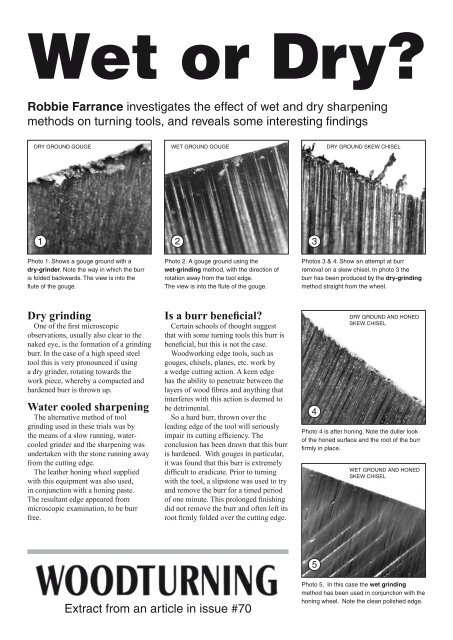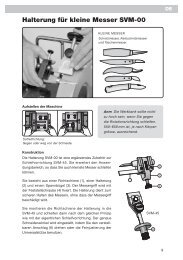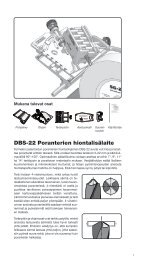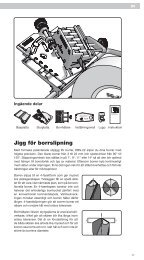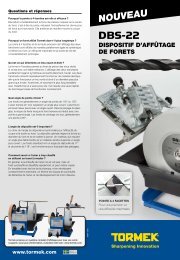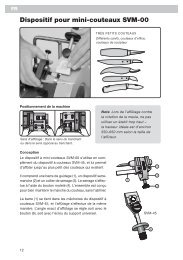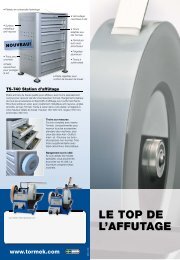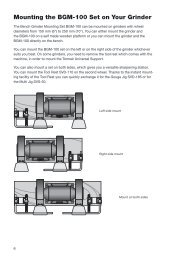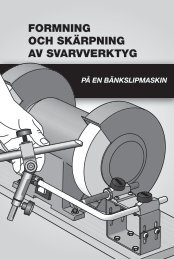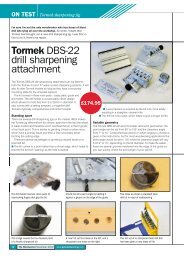wet and dry sharpening - Tormek
wet and dry sharpening - Tormek
wet and dry sharpening - Tormek
Create successful ePaper yourself
Turn your PDF publications into a flip-book with our unique Google optimized e-Paper software.
Wet or Dry<br />
Robbie Farrance investigates the effect of <strong>wet</strong> <strong>and</strong> <strong>dry</strong> <strong>sharpening</strong><br />
methods on turning tools, <strong>and</strong> reveals some interesting findings<br />
DRY GROUND GOUGE WET GROUND GOUGE DRY GROUND SKEW CHISEL<br />
Photo 1. Shows a gouge ground with a<br />
<strong>dry</strong>-grinder. Note the way in which the burr<br />
is folded backwards. The view is into the<br />
flute of the gouge.<br />
Photo 2. A gouge ground using the<br />
<strong>wet</strong>-grinding method, with the direction of<br />
rotation away from the tool edge.<br />
The view is into the flute of the gouge.<br />
Photos 3 & 4. Show an attempt at burr<br />
removal on a skew chisel. In photo 3 the<br />
burr has been produced by the <strong>dry</strong>-grinding<br />
method straight from the wheel.<br />
Dry grinding<br />
One of the first microscopic<br />
observations, usually also clear to the<br />
naked eye, is the formation of a grinding<br />
burr. In the case of a high speed steel<br />
tool this is very pronounced if using<br />
a <strong>dry</strong> grinder, rotating towards the<br />
work piece, whereby a compacted <strong>and</strong><br />
hardened burr is thrown up.<br />
Water cooled <strong>sharpening</strong><br />
The alternative method of tool<br />
grinding used in these trials was by<br />
the means of a slow running, watercooled<br />
grinder <strong>and</strong> the <strong>sharpening</strong> was<br />
undertaken with the stone running away<br />
from the cutting edge.<br />
The leather honing wheel supplied<br />
with this equipment was also used,<br />
in conjunction with a honing paste.<br />
The resultant edge appeared from<br />
microscopic examination, to be burr<br />
free.<br />
Is a burr beneficial<br />
Certain schools of thought suggest<br />
that with some turning tools this burr is<br />
beneficial, but this is not the case.<br />
Woodworking edge tools, such as<br />
gouges, chisels, planes, etc. work by<br />
a wedge cutting action. A keen edge<br />
has the ability to penetrate between the<br />
layers of wood fibres <strong>and</strong> anything that<br />
interferes with this action is deemed to<br />
be detrimental.<br />
So a hard burr, thrown over the<br />
leading edge of the tool will seriously<br />
impair its cutting efficiency. The<br />
conclusion has been drawn that this burr<br />
is hardened. With gouges in particular,<br />
it was found that this burr is extremely<br />
difficult to eradicate. Prior to turning<br />
with the tool, a slipstone was used to try<br />
<strong>and</strong> remove the burr for a timed period<br />
of one minute. This prolonged finishing<br />
did not remove the burr <strong>and</strong> often left its<br />
root firmly folded over the cutting edge.<br />
DRY GROUND AND HONED<br />
SKEW CHISEL<br />
Photo 4 is after honing. Note the duller look<br />
of the honed surface <strong>and</strong> the root of the burr<br />
firmly in place.<br />
WET GROUND AND HONED<br />
SKEW CHISEL<br />
Extract from an article in issue #70<br />
Photo 5. In this case the <strong>wet</strong> grinding<br />
method has been used in conjunction with the<br />
honing wheel. Note the clean polished edge.
Comparative tool cutting efficiency in mm. per sec. For Hardwood.<br />
Comparative tool cutting efficiency in mm. per sec. Softwood.<br />
seconds<br />
This graph shows the collective results of both tool grinding methods<br />
for hardwood. The path lines on all the graphs are seen to undulate.<br />
This is because the data has been reproduced without any statistical<br />
manipulation. This graph, shows very clearly, the peak at which the<br />
burr was worn away from the <strong>dry</strong>-ground tool.<br />
seconds<br />
This graph shows the results of trials performed with softwood A<br />
st<strong>and</strong>ard, group one joinery quality pine was used, <strong>and</strong> selected to be<br />
reasonably knot free. Both tools can be seen to maintain their edge for<br />
a longer period, but the trend for the <strong>wet</strong>-ground tool to achieve higher<br />
results is maintained. Notice the point at which the <strong>dry</strong>-ground burr<br />
disappears. Also of note is the fact that both tools mirror some upward<br />
performance trends, caused by timber density, etc.<br />
Method of investigation<br />
In order to answer some specific<br />
questions as to how <strong>sharpening</strong> methods<br />
may affect the tools, a means of<br />
showing the resultant cutting efficiency<br />
had to be found. It was finally decided<br />
to show how much wood could be<br />
removed by a tool in a measured time,<br />
over a measured distance, giving a<br />
resultant depth or volume of wood<br />
removed.<br />
The equipment used was a K.E.F.<br />
<strong>dry</strong> bench grinder mounted with an<br />
80 grit white wheel <strong>and</strong> a <strong>Tormek</strong> 2004<br />
SuperGrind system, in conjunction with<br />
their Universal Gouge Jig. Honing was<br />
by means of an Arkansas slip stone of<br />
medium grade for the <strong>dry</strong> grind <strong>and</strong> the<br />
manufacturer’s leather honing wheel for<br />
the <strong>wet</strong> grind.<br />
To perform the trials, the tools<br />
were prepared to the same degree of<br />
sharpness, so far as could be judged<br />
by edge ‘feel’ <strong>and</strong> from microscopic<br />
observation, before the start of each<br />
complete ‘run’. This test was repeated<br />
with eight pieces of hardwood <strong>and</strong> eight<br />
pieces of softwood <strong>and</strong> the results are<br />
shown in the graphs.<br />
Whilst these trials proceeded, it<br />
became clear that the <strong>wet</strong> ground tool<br />
was performing better than the <strong>dry</strong><br />
ground, both in terms of durability<br />
of the cutting edge, <strong>and</strong> the finished<br />
surface of the wood.<br />
Best results<br />
The resultant data was assembled in<br />
the form of a graph... The <strong>wet</strong>-ground<br />
tool gave the best results on a consistent<br />
basis, <strong>and</strong> far outlasted the <strong>dry</strong>-ground<br />
tool in terms of durability.<br />
An odd thing was that up to a point,<br />
i.e. three minutes into work time, the<br />
<strong>dry</strong> ground tool seemed to increase its<br />
cutting ability. Fall-off in performance<br />
was fairly marked after this point. The<br />
residual burr, which had proved so<br />
difficult to remove with a slip stone, had<br />
worn away in use. With this protecting<br />
guard gradually being eroded, the tool<br />
had in fact become sharper, until the<br />
burr had completely disappeared.<br />
Conclusions<br />
Using gouges <strong>and</strong> chisels, it would<br />
seem that a universally far better<br />
performance could be obtained by<br />
adopting a <strong>wet</strong> grinding method, in<br />
conjunction with honing. It’s generally<br />
assumed that using a slow-running<br />
water-cooled system will be time<br />
consuming, but this turns out to be more<br />
supposition than fact.<br />
The initial grinding of the tool to<br />
shape (profiling) can take longer but,<br />
once this is achieved, subsequent<br />
grinding is simple, quick, <strong>and</strong> more to<br />
the point can be repeated with a good<br />
degree of accuracy. Adopting the <strong>wet</strong><br />
system does in fact result in a sharpened<br />
edge, in the accepted sense, not just a<br />
coarse-ground bevel.<br />
The <strong>wet</strong>-grinding method leaves a<br />
polished, burr free edge without any<br />
overheating of the tool. This polished<br />
surface creates less friction in use, thus<br />
aiding the durability of the cutting edge.<br />
Due to less frequent <strong>sharpening</strong> with<br />
<strong>wet</strong> grinding, the tool life is significantly<br />
prolonged, since less material is<br />
removed. The <strong>dry</strong> grinding method<br />
leaves a hard compacted burr, which is<br />
very difficult to remove.<br />
The evidence suggests that using a<br />
<strong>wet</strong>-grinding method gives a sharper<br />
edge <strong>and</strong> cleaner cuts with more than<br />
double the effective turning time<br />
between <strong>sharpening</strong>. From the graphic<br />
data, it can be seen that, even after<br />
18 minutes of continuous turning in<br />
softwood, the <strong>wet</strong>-ground tool was still<br />
cutting more than three-<strong>and</strong>-a-half times<br />
faster than the <strong>dry</strong>-ground tool.<br />
The author<br />
Robbie Farrance has spent a lifetime<br />
working with wood <strong>and</strong> its associated<br />
subjects, <strong>and</strong> became a full time teacher<br />
of wood-trades some 12 years ago. He<br />
holds many qualifications including H.N.C.<br />
<strong>and</strong> is a National Assessor. Currently<br />
employed by the Royal National Institute<br />
for the Blind, it is for his work in pioneering<br />
methods of teaching blind <strong>and</strong> partially<br />
sighted students, that he has gained<br />
national <strong>and</strong> international recognition.<br />
Tel. UK 01803 214 523


